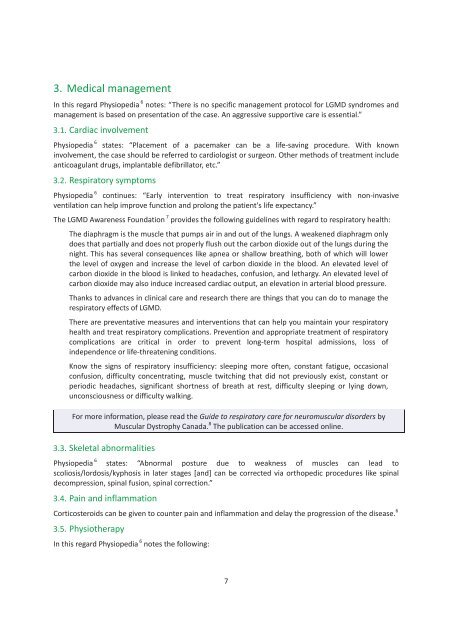You also want an ePaper? Increase the reach of your titles
YUMPU automatically turns print PDFs into web optimized ePapers that Google loves.
3. Medical management<br />
In this regard Physiopedia 6 notes: “There is no specific management protocol for <strong>LGMD</strong> syndromes and<br />
management is based on presentation of the case. An aggressive supportive care is essential.”<br />
3.1. Cardiac involvement<br />
Physiopedia 6 states: “Placement of a pacemaker can be a life-saving procedure. With known<br />
involvement, the case should be referred to cardiologist or surgeon. Other methods of treatment include<br />
anticoagulant drugs, implantable defibrillator, etc.”<br />
3.2. Respiratory symptoms<br />
Physiopedia 6 continues: “Early intervention to treat respiratory insufficiency with non-invasive<br />
ventilation can help improve function and prolong the patient's life expectancy.”<br />
The <strong>LGMD</strong> Awareness Foundation 7 provides the following guidelines with regard to respiratory health:<br />
The diaphragm is the muscle that pumps air in and out of the lungs. A weakened diaphragm only<br />
does that partially and does not properly flush out the carbon dioxide out of the lungs during the<br />
night. This has several consequences like apnea or shallow breathing, both of which will lower<br />
the level of oxygen and increase the level of carbon dioxide in the blood. An elevated level of<br />
carbon dioxide in the blood is linked to headaches, confusion, and lethargy. An elevated level of<br />
carbon dioxide may also induce increased cardiac output, an elevation in arterial blood pressure.<br />
Thanks to advances in clinical care and research there are things that you can do to manage the<br />
respiratory effects of <strong>LGMD</strong>.<br />
There are preventative measures and interventions that can help you maintain your respiratory<br />
health and treat respiratory complications. Prevention and appropriate treatment of respiratory<br />
complications are critical in order to prevent long-term hospital admissions, loss of<br />
independence or life-threatening conditions.<br />
Know the signs of respiratory insufficiency: sleeping more often, constant fatigue, occasional<br />
confusion, difficulty concentrating, muscle twitching that did not previously exist, constant or<br />
periodic headaches, significant shortness of breath at rest, difficulty sleeping or lying down,<br />
unconsciousness or difficulty walking.<br />
For more information, please read the Guide to respiratory care for neuromuscular disorders by<br />
Muscular Dystrophy Canada. 8 The publication can be accessed online.<br />
3.3. Skeletal abnormalities<br />
Physiopedia 6 states: “Abnormal posture due to weakness of muscles can lead to<br />
scoliosis/lordosis/kyphosis in later stages [and] can be corrected via orthopedic procedures like spinal<br />
decompression, spinal fusion, spinal correction.”<br />
3.4. Pain and inflammation<br />
Corticosteroids can be given to counter pain and inflammation and delay the progression of the disease. 6<br />
3.5. Physiotherapy<br />
In this regard Physiopedia 6 notes the following:<br />
7

















